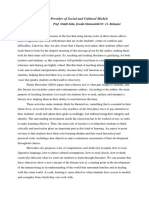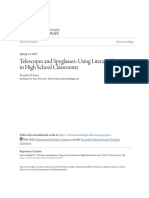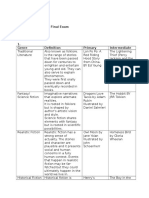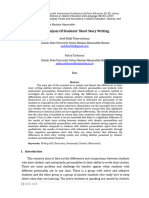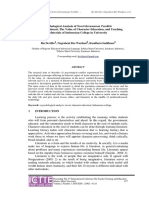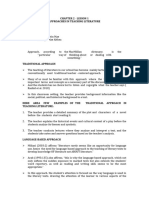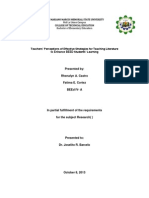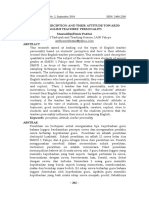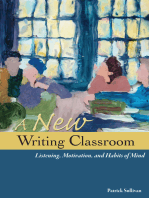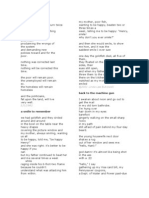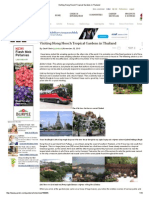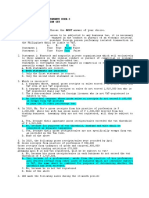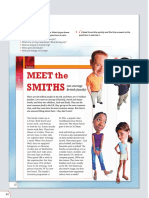Professional Documents
Culture Documents
Attitudes of Doctor of Philosophy in Education Major in English Students Toward Teaching Fiction
Attitudes of Doctor of Philosophy in Education Major in English Students Toward Teaching Fiction
Copyright
Available Formats
Share this document
Did you find this document useful?
Is this content inappropriate?
Report this DocumentCopyright:
Available Formats
Attitudes of Doctor of Philosophy in Education Major in English Students Toward Teaching Fiction
Attitudes of Doctor of Philosophy in Education Major in English Students Toward Teaching Fiction
Copyright:
Available Formats
ATTITUDES OF DOCTOR OF PHILOSOPHY IN
EDUCATION MAJOR IN ENGLISH STUDENTS
TOWARD TEACHING FICTION
PSYCHOLOGY AND EDUCATION: A MULTIDISCIPLINARY JOURNAL
2023
Volume: 7
Pages: 675-681
Document ID: 2023PEMJ590
DOI: 10.5281/zenodo.7750433
Manuscript Accepted: 2023-15-3
Psych Educ, 2023, 7: 675-681, Document ID:2023 PEMJ590, doi:10.5281/zenodo.7750433, ISSN 2822-4353
Research Article
Attitudes of Doctor of Philosophy in Education Major in English
Students TowardTeaching Fiction
Mark Joshua D. Roxas*, Chester John D. Pasco, Kassandra Chelzea Banalan, Eborah Limbo
Myline R. Manlapat, Alain F. Razalan
For affiliations and correspondence, see the last page.
Abstract
This paper aimed to assess the attitude of the respondents in teaching fiction in terms of the strategies, selection
of text; and springboard for teaching grammar. Moreover, the study intended to identify if there is a significant
difference between the attitude of the respondents in teaching fiction when grouped according to demographic
profile. To fulfill the said goals, this Descriptive-Quantitative study utilized purposive sampling to select ten (10)
Doctor of Philosophy major in English students who are teaching literature. The data were gathered through an
adapted survey questionnaire, and were analyzed through descriptive (mean, frequency, and percentage), and
inferential (ANOVA and T-Test) analyses. The results revealed that the respondents generally manifest a “Very
Positive” attitude in all aspects of teaching fiction such as strategies, selection of text, and springboard for
teaching grammar. Furthermore, when grouped according to demographics, the analysis revealed no significant
difference between attitude, age, and years of teaching. Interestingly, a significant difference exists between
attitude and sex (p=0.38). Ultimately, it was recommended to investigate the attitude of the students toward the
use of fictional texts in the classroom as this study mainly focused on the teachers’ attitude. Teachers should also
look for ways on how to connect fictional stories to the lives of the students and to look closely on the diverse
needs of learners in the selection of appropriate teaching strategies and fictional texts. Social and moral contexts
should also be given emphasis.
Keywords: attitudes, fiction, literature, strategies
Introduction imaginatively (Abida, 2016).
Literature teaches students a variety of skills including According to Fakoya and Ogunpitan (2001), the
speaking, writing, and reading. In the instruction of process by which a reader of a work of literature
literature, students are not limited to interpretation and develops a meaningful grasp of the work's theme and a
analysis but it also fosters a sense of sensitivity, self- unique understanding of its structure can be referred to
awareness, and a deeper understanding of the world as literary appreciation. Students have the chance to
and other people. According to Mallikarjun (2003), consider and assess their own value as persons through
literature that is studied for its intrinsic value and literature in its purest form. One of the attributions to
enjoyment is a potent teaching tool that instills values, achieving all of the mentioned competencies is the
a language-use style, and several other learning teachers’ attitude in teaching literature, fiction in
chances into the minds of learners. Literature serves as particular.
both a context and an illustration of language use.
Revisiting teachers’ attitude in teaching fiction could
One of the key results of teaching literature is the raise awareness on improving students' literacy skills.
development of literary competence. This refers to the Such data will also outline actions that teachers can
process by which students internalize literary take to enhance their instruction, particularly in the
grammar, enabling them to translate language patterns area of fiction in their literature classes.
into literary structures and meanings. Reading
comprehension texts in general calls for distinct Different academics have defined attitudes in different
abilities in literature. The ability to appreciate ways. According to Gardner (1980), a man's attitude is
literature is one of the traits under literary competence. the culmination of his instincts, feelings, prejudices, or
brains, as well as his preconceived notions, fears,
Engaging with subjects and topics that are innately threats, and convictions regarding any given topic.
appealing is what makes reading literature enjoyable. Tuckman (1992) as cited in Singh et al. (2020) defines
They are able to connect what they are reading with attitude as “a cognitive function of a human being
their own lives since it deals with concepts, objects, expressed through the affective domains. It is
sensations, and events that either are a part of the considered as an individual’s continuing interpretation,
reader's experience or that they may enter into general feeling or liking and disliking on any event,
person or any behavior.” According to Baker (1992) as
Roxas et al. 675/681
Psych Educ, 2023, 7: 675-681, Document ID:2023 PEMJ590, doi:10.5281/zenodo.7750433, ISSN 2822-4353
Research Article
cited in Holmes and Wilson (2017), attitude is a used in its most restrictive definition to refer to any
theoretical construct that is used to describe the course "literary tale" (Farner, 2014 as cited in Van Krieken,
and durability of human behavior. 2017).
Because attitude cannot be seen directly, it must be The activity of writing fiction should be emphasized
deduced from overt conduct, both verbal and since it helps people grow creatively and personally.
nonverbal, which is why this study was done to The world is changing quickly, and creativity is often
determine the attitude of literature teachers in teaching necessary to keep up. "In our rapidly changing world,
fiction. only a few abilities other than creativity can be listed
for the growth of people," says one author (Ataman,
Research Questions 1993). "During the 1950s, the notion that writing
creative fiction would improve psychological relief
To have guidance and direction in the investigation, (catharsis, in a sort) was common, and practices
the following research questions were formulated: mirrored this. It was predicated on the idea that writing
creative fiction may serve as a vehicle for
1. What is the demographic profile of the respondents externalizing the stress, unbalance, and spiritual
in terms of the following: despair brought on by World War II on human
1.1. age; psychology (Temizkan, 2010).
1.2. sex; and
1.3. years of teaching? The subjects covered by fiction might change.
2. What is the attitude of the respondents in teaching However, they are all connected to human behavior or
fiction in terms of the following: experience used to interpret life, amuse, instruct, or
2.1. strategies; inspire people or to capture the spirit of the time. It
2.2. selection of text; and might be purely an imagination or based on facts. It
2.3. springboard for teaching grammar? can be used to examine personal emotions and
3. Is there a significant difference between the attitude thoughts, a successful but outdated paradigm, or
of the respondents in teaching fiction when grouped opposing principles or ideologies. It could be set in an
according to: environment that's taken from typical daily life or in a
3.1. age; strange and creative moment.
3.2. sex; and
3.3. years of teaching? Strategies in teaching fiction
When the teacher uses effective teaching strategies in
Literature Review the classroom, teaching literature can become
engaging and interesting. Teachers frequently either
lecture or employ question-and-answer or recitation
Fiction techniques. Because the query is almost never how and
why, but rather who-what-when-where, recitation is
The term "fiction" refers to a literary work that uses frequently inappropriate. According to Sert (2019), the
prose written words to create something (the subject role of the teacher is to develop and strengthen
matter) that symbolizes human existence. It is derived students' intelligence. In the traditional method of
from the Latin word "fictus," which means "to form," teaching literature, the teacher mainly concentrates on
or " fictiō," which means "the process of forming, language skills like reading, remembering, and reciting
fashioning, or shaping." literary works.
In fiction, the author assumes that readers will make an In reality, Soltan (2010) as cited in Magulod (2018)
effort to follow and understand a theme that is discovered that the lecture technique is used by the
developed indirectly or abstractly, whereas nonfiction majority of literary educators. As a result, rather than
writing is more concerned with providing information reading the original literary text, many students rely
directly (Woolf, 2010). solely on the critical remarks provided by their
teachers. Learning about literature thus becomes
Any setting or story that is based on imagination rather tedious.
than completely on history or reality is categorized as
fiction. The literary genre of fiction most frequently Effective instructors, according to Stoop (2011) as
refers to narrative works like plays, short tales, poems, cited in Jepketer (2017), recognize student differences,
novels, and novellas. Sometimes the term "fiction" is foster collaborative learning connections,
Roxas et al. 676/681
Psych Educ, 2023, 7: 675-681, Document ID:2023 PEMJ590, doi:10.5281/zenodo.7750433, ISSN 2822-4353
Research Article
communicate openly with parents, provide students In a poem, ideas and feelings are expressed in little
feedback, and employ techniques that empower sentences without sacrificing rhyme or meter. Poets
students to be in charge of their own learning. use linguistic convention by using language that
Jepketer, Kombo, and Kyalo's (2015) findings are deviates from it to attain these goals (in terms of
further evidence that instructional practices have an lexical, semantic, phonological, morphological, and
impact on and reinforce student achievement. A well- syntactical domain). Drama is a literary genre that is
designed educational system is determined by intend ed to be acted out, spok en, or seen
variables such as effective teaching and learning, (Angelianawati, 2019). The students will first engage
which are markers of excellent teachers and with the language structures and content of the work
instructional performance. through reading and analysis before using theater in
the EFL classroom.
The teacher will accomplish seamless instruction by
using an accurate method. The methods employed The use of novels in EFL classes has four advantages,
must be adjusted to the goals when they are set in according to Siaj and Farrah (2018). First, books can
enhance and motivate learning resources (Chen &
order for students to acquire certain abilities. So that
Tsai, 2012). Second, books are said to broaden
they can be used as effective tools to accomplish their
students' cultural knowledge. Third, using novels helps
objectives, teachers must therefore employ approaches
students improve their language skills, just as using
that complement teaching and learning activities.
other literary genres. Additionally, students' four
language skills—reading, writing, speaking, and
Selection of texts to be used
listening—improve when reading novels. Fourth,
reading novels helps students grasp and interpret the
Selecting the work to teach is one of the most
target language. According to Pinar and Jover's (2012)
important elements to take into account. According to
as cited in Arafah (2018), books with several levels of
Mckay (1982) as cited in Bloemert et al. (2019),
meaning make it easier for students to explain and
choosing the right literature is "the key to success in
infer meaning.
employing literature in the ESL." Language
proficiency, personal involvement, length (it fits the
time allotted), cultural competence, intellectual merit Methodology
(the issues and ideas explored in the work should be
pertinent, interesting, and challenging to students),
literary merit (the work is really worthy of academic The paper used a quantitative method, specifically the
study), and contemporary literature are the most descriptive research design. Quantitative research is
about explaining phenomena by collecting quantitative
crucial factors to consider when choosing literary
data which are analyzed using mathematically-based
works to use (it uses modern English). Fortunately,
method (Sukamolson, 2007). Moreover, this
fiction contains both novels and short tales, so the
descriptive research attempts to collect quantifiable
length and complexity requirements can be satisfied.
information for statistical analysis of the population
sample. This research method allows the researchers to
Use of fiction in teaching grammar
collect and describe the demographic segment’s
nature. As utilized in the study, the demographic
The concern about language development suggests an
profile of the respondents and the attitude of the
instrumental view on teaching and reading fiction,
respondents in teaching fiction are given descriptions
which is aligned with Johansson’s (2014) as cited in
and established concepts on how teachers perceive
Yang (2019) notion that there is a correlation between their teaching of fiction; their strategies, material
the sole focus on reading comprehension and selection, and how teaching fiction is an instrument in
proficiency on one hand, and instrumentality on the teaching grammar.
other. This is supported by teachers’ use of fiction as
material for teaching literacy. Population and Sampling
Pardede (2019) said that fiction is thought to be the The respondents of the study are ten (10) students who
literary type that works best in EFL classrooms out of are currently enrolled in the Doctor of Philosophy in
the three. Fiction is defined as to invented stories, or Education major in English program who teach or
stories created grounded on imagination, which have taught literature courses. The respondents are five
includes novels, short stories, novels, romances, (5) males and five (5) female students, ages less than
fables, and other narrative works in prose. 30 to more than 50 years old, who have been teaching
Roxas et al. 677/681
Psych Educ, 2023, 7: 675-681, Document ID:2023 PEMJ590, doi:10.5281/zenodo.7750433, ISSN 2822-4353
Research Article
for less than five years to more than 20 years in both The attitude of the respondents in teaching fiction in
public and private schools and universities. The paper terms of strategies; selection of text; a springboard
utilized purposive sampling technique. Purposive for teaching grammar
sampling is used since the researchers want to access a
particular subset of people, as all participants of a
Table 2. Attitude of the Respondents in Teaching
survey are selected because they fit a particular profile,
the respondents are all Doctor of Philosophy in
Fiction in Terms of Strategies
Education major in English students who teach
literature/fiction.
Research Instrument
The investigation modified and adopted the research
instrument of Lihanda & Agufana (2017), Al-Matrafi
(2022), and the researchers sought approval for
questionnaire validation before the instrument was
distributed to the respondents. The recruitment was
conducted through messenger and participants were
given a link to a survey questionnaire in Google forms.
The questionnaire is divided into two parts. The first
part is the demographic profile of the respondents. The
second part is to gauge the attitude of the respondents
in teaching fiction.
Results and Discussion As revealed in Table 2, the respondents manifest a
Very Positive attitude toward various strategies in
teaching fiction. The respondents truly adhere to the
The demographic profile of the respondents in terms
idea that varied teaching strategies shall be used in
of age, sex, and years of teaching teaching fiction in order to cater to the diverse needs of
the learners (x̄=3.90). Additionally, the respondents
Table 1. Demographic Profile of the Respondents
also aver that fiction stories can be integrated in other
disciplines for a more effective delivery of instruction
(x̄=3.90).
Table 3. Attitude of the Respondents in Teaching
Fiction in Terms of Selection of Text
As seen in Table 1, the majority of the respondents
belong to the “Less than 30 years old” and “30-50
years old” age bracket, both constituting 40% of the
sample size. In terms of sex, 50% is Female, and 50%
is Male. Relative to the years of teaching, the majority
of the respondents, or 70% belong to the 5-10 years of
teaching bracket.
Roxas et al. 678/681
Psych Educ, 2023, 7: 675-681, Document ID:2023 PEMJ590, doi:10.5281/zenodo.7750433, ISSN 2822-4353
Research Article
Table 5. ANOVA Result on the Difference between the
Attitude of the Respondents in Teaching Fiction When
Grouped According to Age
As shown in Table 3, the respondents manifest a Very
Positive attitude toward the selection of text in
teaching fiction. The respondents tend to choose texts
or stories that are interesting to the learners (x̄=4.00).
This is probably anchored on the idea that if the
students are interested in what they are reading, then
they tend to learn better. This is parallel with the
findings of Siaj and Farrah (2018) that books can
enhance and motivate learning resources (Chen & Based on the result of the ANOVA test statistic, since
Tsai, 2012). Moreover, the respondents are also very the P-value is greater than the level of significance
positive that fiction texts are easily accessible (0.05), the researchers failed to reject the null
(x̄=3.80). Cultural context and discussion of societal hypothesis. Meaning, there is no significant difference
and moral issues are also some of the considerations of in the attitudes of the respondents when grouped
the respondents in choosing a fiction text (x̄=3.80). according to age.
Similarly, as noted by Chen & Tsai (2012) books are
said to broaden students' cultural knowledge. Table 6. T-Test Result on the Difference between the
Attitude of the Respondents in Teaching Fiction When
Table 4. Attitude of the Respondents in Using Fiction Grouped According to Sex
as Springboard for Teaching Grammar
It can be gleaned from Table 4 that the respondents As seen in Table 6, since the P-value (0.05) is equal to
possess a “Very Positive” attitude in all aspects of the level of significance (0.05), the researchers
using fiction to teach grammar. The respondents rejected the null hypothesis, which means that there is
claimed that they enjoy using short fiction stories in a significant difference on the attitudes of the
teaching grammar (x̄=3.60). The use of fiction respondents when grouped according to sex.
stories to correct common English grammar mistakes
is also very evident from the attitudes of the Table 7. ANOVA Result on the Difference between the
respondents (x̄=3.50). Attitude of the Respondents in Teaching Fiction When
Grouped According to Years of Teaching
The significant difference between the attitude of the
respondents in teaching fiction when grouped
according to the respondents' demographic profile
Roxas et al. 679/681
Psych Educ, 2023, 7: 675-681, Document ID:2023 PEMJ590, doi:10.5281/zenodo.7750433, ISSN 2822-4353
Research Article
English Educators Society), 1(1), v1i1-148.
As revealed in Table 7, since the P-value (0.17) is Agufana, P.B. & Lihanda, M. (2017). Attitude factors affecting
greater than the level of significance (0.05), the teachers’ use of short stories in the teaching of Kiswahili grammar in
secondary schools in Nandi North Sub-County, Kenya. European
researchers failed to reject the null hypothesis. It can
Scientific Journal. 13(29), 172-181.
be concluded that there is no significant difference in h t t p : / / d x . d o i . o rg / 1 0 . 1 9 0 4 4 / e s j . 2 0 1 7 . v 1 3 n 2 9 p 17 2
the attitudes of the respondents when grouped
according to years of teaching. Angelianawati, L. (2019). Using Drama in EFL Classroom. Journal
of E n g l i s h Teaching, 5(2), 125-134. DOI:
h t t p : / / d x . d o i . o rg / 1 0 . 3 3 5 4 1 / j e t . v 5 i 2 . 1 0 6 6
Conclusion Arafah, B. (2018). Incorporating the use of literature as an
innovative technique for teaching English. KnE Social Sciences, 24-
36.
This study aimed to determine the Doctor of
Baker, C. (1992). Attitudes and language (Vol. 83). Multilingual
Philosophy in Education major in English students’
Matters.
attitude towards teaching fiction with the consideration
of the respondents’ profile, attitude towards strategies, Bloemert, J., Paran, A., Jansen, E., & van de Grift, W. (2019).
selection of text, and springboard for teaching Students’ perspective on the benefits of EFL literature education.
The Language Learning Journal, 47(3), 371-384.
grammar. It employed the descriptive research design,
involving the purposive random sampling method of Chen, S., & Tsai, Y. (2012). Research on English teaching and
the Doctor of Philosophy in Education major in learning: Taiwan (2004–2009). Language Teaching, 45(2), 180-201.
English program students. The study shows that, in
(n.d.) Descriptive Research: Definition, Characteristics, Methods,
general, the doctorate students manifest a very positive Examples and Advantages, Retrieved from
attitude toward teaching fiction. The respondents https://www.questionpro.com/blog/descriptive-research/
adhere to the concept that varied teaching strategies
Fakoya, A. A., & Ogunpitan, S. A. (2001). The English
should be utilized in teaching fiction in order to
Compendium 3 & 4. Lagos: Department of English, Lagos State
address the different needs of the learners. Also, the University.
respondents show a very positive attitude toward
choosing texts or stories that the learners resonate Gardner, R. C. (1980). On the validity of affective variables in
with. As to their attitude toward using fiction as a second language acquisition: conceptual, contextual, and statistical
considerations 1. Language learning, 30(2), 255-270.
springboard for teaching grammar, the respondents
exhibit a very positive attitude in all aspects in Holmes, J., & Wilson, N. (2017). An introduction to sociolinguistics.
teaching grammar with fiction as a starter. Routledge.
Jepketer, A. N. N. A. H. (2017). Influence of teaching strategies on
For future research, first, it would be possible to
students’ performance in academic achievement and co-curricular
investigate the attitude of the students toward the use activities in public secondary schools in Nandi county, Kenya.
of fictional texts in the classroom from their vantage Unpublished MED Thesis). Kenyatta University.
point as this study mainly focused on the teachers’
Magulod, G.C. (2018). Innovative learning tasks in enhancing the
attitude. Second, since teachers have a very positive
literary appreciation skills of students. Sage Open. I-II. 2-9.
attitude toward teaching fiction, they should look for https://journals.sagepub.com/doi/full/10.1177/2158244018820382
ways on how to connect fictional stories to the lives of
the students and integrate these texts in other Mallikarjun, B. (2003). Use of folk literature from a pedagogical
disciplines for further instruction as well as perspective. Language in India, 3.
appreciation. Third, literature teachers should continue Pardede, P. (2019). Using fiction to promote students’ critical
to look closely on the diverse needs of learners in the thinking. Journal of English Teachers. 5(3), 166-175.
selection of appropriate teaching strategies and http://dx.doi.org/10.33541/jet.v5i3.1309
fictional texts that arouse students’ interests. Finally,
Poke, W. Sullivan, K., & Leavenworth, M. (2019). Teaching fiction
although teachers enjoy teaching grammar with fiction in the age of measurability: Teachers’ perspectives on the hows and
as a springboard, they should also be selective with the what s in S w e d i s h L1 c l a s s r o o m. R e t ri e v e d from
texts that contain social and moral contexts. https://www.researchgate.net/publication/334284184_Teaching_ficti
on_in_the_age_of_measurability_Teachers'_perspectives_on_the_ho
ws_and_whats_in_Swedish_L1_classrooms
References
(n . d . ) Pu rp o s i v e Sa m p l i n g 101. R e t r i e v e d from
https://www.alchemer.com/resources/blog/purposive-sampling-101/
Abida, F. I. N. (2016). Critical thinking skills to literary works: A
method of teaching language through literature. JEES (Journal of Sert, O. (2019). Classroom interaction and language teacher
education. In The Routledge handbook of English language teacher
Roxas et al. 680/681
Psych Educ, 2023, 7: 675-681, Document ID:2023 PEMJ590, doi:10.5281/zenodo.7750433, ISSN 2822-4353
Research Article
education (pp. 216-238). Routledge. Affiliations and Corresponding Information
Siaj, R., & Farrah, M. (2018). Using Novels in the Language
Classroom at Hebron University.
Mark Joshua D. Roxas
Singh, Shiba, et al. “A Study of Attitude of Teachers towards University of Perpetual Help System DALTA – Philippines
Inclusive Education.” Shanlax International Journal of Education,
vol. 9, no. 1, 2020, pp. 189-197 Chester John D. Pasco
Sussex Central High School, Virginia - USA
Sukamolson, Suphat Ph.D. (2017) Fundamentals of Quantitative
Research. Language Institute Chulalongkorn University, Retrieved Kassandara Chelzea Banalan
from file:///SuphatSukamolson.pdf
Makiling Integrated School – Philippines
Van Krieken, K., Hoeken, H., & Sanders, J. (2017). Evoking and
measuring identification with narrative characters–A linguistic cues Eborah Limbo
framework. Frontiers in psychology, 8, 1190. Palahanan Integrated National High School - Philppines
Woolf, B. P. (2010). Building intelligent interactive tutors: Student- Myline R. Manlapat
centered strategies for revolutionizing e-learning. Morgan Golden Acres Elementary School
Kaufmann. Department of Education - Philippines
Yang, X., Kaiser, G., König, J., & Blömeke, S. (2018). Measuring Alain F. Razalan
Chinese teacher professional competence: adapting and validating a
University of Perpetual Help System DALTA - Philippines
German framework in China. Journal of Curriculum Studies, 50(5),
638-653.
Roxas et al. 681/681
You might also like
- Make Book For IpadDocument198 pagesMake Book For IpadDann Allack100% (4)
- Teaching From A Disciplinary Literacy StanceDocument6 pagesTeaching From A Disciplinary Literacy StancesherrymiNo ratings yet
- Intertextual Study Unit Plan Tkam Jasper JonesDocument12 pagesIntertextual Study Unit Plan Tkam Jasper Jonesapi-474141182100% (2)
- Object-Oriented-Design Course-Notes PDFDocument93 pagesObject-Oriented-Design Course-Notes PDFApoorv AgarwalNo ratings yet
- MAJ 17 Lesson 1Document12 pagesMAJ 17 Lesson 1March MarchNo ratings yet
- Chapter 2 - ENG 120 HandoutsDocument7 pagesChapter 2 - ENG 120 HandoutsCarl JohnNo ratings yet
- Analytic ReadingDocument24 pagesAnalytic Readingbersam05No ratings yet
- El Ed 122 Pedagogical Implications LectureDocument5 pagesEl Ed 122 Pedagogical Implications LectureValorie C. Baliw-anNo ratings yet
- The Problem and Its BackgroundDocument68 pagesThe Problem and Its Backgroundshara santosNo ratings yet
- "There Is A Great Deal of Difference Between An Eager Man Who Wants To Read A Book and A Tired Man Who Wants A Book To Read." (p.43)Document11 pages"There Is A Great Deal of Difference Between An Eager Man Who Wants To Read A Book and A Tired Man Who Wants A Book To Read." (p.43)CRox's BryNo ratings yet
- Academic Writing Rahayu SaraswatiDocument8 pagesAcademic Writing Rahayu SaraswatiSaraswati RahayuNo ratings yet
- El Ed 122 Pedagogical Implications LectureDocument5 pagesEl Ed 122 Pedagogical Implications Lecturemtkho1909No ratings yet
- EJ1253934Document25 pagesEJ1253934Jam ZhangNo ratings yet
- Engaging Literary Competence Through Critical Literacy in An EFL SettingDocument4 pagesEngaging Literary Competence Through Critical Literacy in An EFL SettingCyril FalculanNo ratings yet
- Literature - Provider of Models, Iulia OstafiDocument5 pagesLiterature - Provider of Models, Iulia OstafiIulia OstafiNo ratings yet
- DE LEON, PRINCESS JAIDILEIA F. - BECED II-16 - TASK 2 Reading Analysis ReportDocument3 pagesDE LEON, PRINCESS JAIDILEIA F. - BECED II-16 - TASK 2 Reading Analysis ReportPRINCESS JAIDILEIA DE LEONNo ratings yet
- Telescopes and Spyglasses - Using Literary Theories in High SchoolDocument37 pagesTelescopes and Spyglasses - Using Literary Theories in High Schoolmaria jose suarezNo ratings yet
- AnnotationsDocument5 pagesAnnotationsKathryn BrightwellNo ratings yet
- The Advantages of Literature To LearnersDocument7 pagesThe Advantages of Literature To LearnersNicole RapaNo ratings yet
- Annotated Bibliography (Vina Fauziah F)Document8 pagesAnnotated Bibliography (Vina Fauziah F)Vina Fauziah F.No ratings yet
- Research Paper On Content Area Reading StrategiesDocument76 pagesResearch Paper On Content Area Reading StrategiesROMNICK SANCADANo ratings yet
- Enhancing The Self-Esteem of Undergraduates in A MalaysianDocument16 pagesEnhancing The Self-Esteem of Undergraduates in A MalaysianSowmiya RsNo ratings yet
- Telescopes and Spyglasses Using Literary Theories in High School ClassroomsDocument37 pagesTelescopes and Spyglasses Using Literary Theories in High School ClassroomsMark LaboNo ratings yet
- Approaches in Teaching Literature Classes Information-Based ApproachDocument2 pagesApproaches in Teaching Literature Classes Information-Based ApproachLezil O. CalutanNo ratings yet
- Interiorizing Ethics Through Science Fiction - Cascales EcharteDocument17 pagesInteriorizing Ethics Through Science Fiction - Cascales EcharteJavier JiménezNo ratings yet
- Afoa Annotated BibDocument20 pagesAfoa Annotated Bibapi-720953259No ratings yet
- Students' Short Story Writing AnalysisDocument13 pagesStudents' Short Story Writing Analysisandi rizNo ratings yet
- Role PlayDocument61 pagesRole PlayGeraldine Peralta100% (1)
- Lake 2014Document15 pagesLake 2014Su MintNo ratings yet
- 572-Article Text-2084-1-10-20191125Document22 pages572-Article Text-2084-1-10-20191125Audry Keisha RahadianNo ratings yet
- Analysis of Moral Values of 9Th Grade Students' Reading TextsDocument11 pagesAnalysis of Moral Values of 9Th Grade Students' Reading TextsDefita AnggrainiNo ratings yet
- Teaching and Assessment of Literature Studies Handout - 2Document22 pagesTeaching and Assessment of Literature Studies Handout - 2Hanifa PaloNo ratings yet
- 978-981-287-588-4 - 100015 InglesDocument66 pages978-981-287-588-4 - 100015 Inglesjose luisNo ratings yet
- Reader Response Theory and PedagogiesDocument15 pagesReader Response Theory and PedagogiesMarkaela Bryan100% (1)
- 02 Chapter 2Document39 pages02 Chapter 2jmmagaddatu06No ratings yet
- Pedagogy and LiteratureDocument6 pagesPedagogy and LiteratureFred MukokoNo ratings yet
- Ej 1001528Document4 pagesEj 1001528JnjkkoNo ratings yet
- Final Rhetorical Analysis RetanaDocument6 pagesFinal Rhetorical Analysis Retanaapi-459771935No ratings yet
- Final ThesisDocument101 pagesFinal ThesisHazel Sabado DelrosarioNo ratings yet
- Pedagogical Implications For Teaching Literature: Lesson 2Document4 pagesPedagogical Implications For Teaching Literature: Lesson 2Berlyn D. AlmandaresNo ratings yet
- Davies Florence 1995 Introducing Reading Davies FLDocument10 pagesDavies Florence 1995 Introducing Reading Davies FLAbbaa CabsaaNo ratings yet
- Psycholinguistic Correlates of Progress in Literature at Russian Vocational Training School: A Snap Shot From Selected PaperDocument5 pagesPsycholinguistic Correlates of Progress in Literature at Russian Vocational Training School: A Snap Shot From Selected PaperREILA Journal of Research and Innovation in LanguageNo ratings yet
- Andirizki Pra jurnal-input-NTDocument11 pagesAndirizki Pra jurnal-input-NTandi rizNo ratings yet
- Learning Styles, Psychological Types and Adult Learning TheoriesDocument31 pagesLearning Styles, Psychological Types and Adult Learning TheoriesSafiyaPiroNo ratings yet
- Lesson 2 Pedagogical Implications For Teaching LiteratureDocument10 pagesLesson 2 Pedagogical Implications For Teaching LiteratureLarie CanoNo ratings yet
- Introduction To Alternative Literature: Curriculum Proposal Melissa Perlman EDU 603 Curriculum 2.0 Dr. Jennifer WojcikDocument32 pagesIntroduction To Alternative Literature: Curriculum Proposal Melissa Perlman EDU 603 Curriculum 2.0 Dr. Jennifer Wojcikapi-405402350No ratings yet
- Psychological Analysis of Novel Kerumunan Terakhir by Okky Madasari, The Value of Character Education, and TeachingDocument8 pagesPsychological Analysis of Novel Kerumunan Terakhir by Okky Madasari, The Value of Character Education, and TeachingPuja Ananda Maratus SolichahNo ratings yet
- Pharma JournalsDocument5 pagesPharma JournalssanaNo ratings yet
- Disciplinary Literacy Strategies To Support Transactions in Elementary Social StudiesDocument11 pagesDisciplinary Literacy Strategies To Support Transactions in Elementary Social Studiesmissjoseph0803No ratings yet
- Chaps ReviewsDocument8 pagesChaps ReviewsAngelica Mae G. AlvarezNo ratings yet
- Concept Paper 2Document5 pagesConcept Paper 2Costales Fea Franzielle C.No ratings yet
- CHAPTER 2 LESSON 1 - Approaches in Teaching LiteratureDocument2 pagesCHAPTER 2 LESSON 1 - Approaches in Teaching LiteratureMae Althea TidalgoNo ratings yet
- Dexis and WritingDocument15 pagesDexis and WritingSara EldalyNo ratings yet
- Teachers' Perceptions of Effective Strategies For Teaching Literature To Enhance BEED Students' LearningDocument6 pagesTeachers' Perceptions of Effective Strategies For Teaching Literature To Enhance BEED Students' LearningnylanehrNo ratings yet
- Jurnal KepribadianDocument17 pagesJurnal KepribadianZakiyahNurHumairaNo ratings yet
- Narrative Inquiry As A Mediational Space ExaminingDocument22 pagesNarrative Inquiry As A Mediational Space Examiningarefe samadiNo ratings yet
- Authentic Literacy Duke-Science-Rt 60 4 41Document12 pagesAuthentic Literacy Duke-Science-Rt 60 4 41api-264543623No ratings yet
- The Teaching of Literature PDFDocument6 pagesThe Teaching of Literature PDFReyna Ediza Adelina EstremosNo ratings yet
- The Teaching of LiteratureDocument6 pagesThe Teaching of LiteratureReyna Ediza Adelina EstremosNo ratings yet
- Lesson 1 ContextDocument2 pagesLesson 1 ContextTomisin KoladeNo ratings yet
- A New Writing Classroom: Listening, Motivation, and Habits of MindFrom EverandA New Writing Classroom: Listening, Motivation, and Habits of MindNo ratings yet
- Post-Pandemic Performance in Content Mastery and Cognitive Skills of Junior High School Students in ChemistryDocument7 pagesPost-Pandemic Performance in Content Mastery and Cognitive Skills of Junior High School Students in ChemistryPsychology and Education: A Multidisciplinary JournalNo ratings yet
- Psychology and Education: A Multidisciplinary JournalDocument11 pagesPsychology and Education: A Multidisciplinary JournalPsychology and Education: A Multidisciplinary JournalNo ratings yet
- Influence of Teacher's Personality and Behavior On Students Character BuildingDocument8 pagesInfluence of Teacher's Personality and Behavior On Students Character BuildingPsychology and Education: A Multidisciplinary JournalNo ratings yet
- Self-Concept and Level of Career Interest of Grade 9 Students at San Roque National High SchoolDocument10 pagesSelf-Concept and Level of Career Interest of Grade 9 Students at San Roque National High SchoolPsychology and Education: A Multidisciplinary JournalNo ratings yet
- Unlocking Opportunities: The Key To Successful Destigmatization of Ex-OffendersDocument11 pagesUnlocking Opportunities: The Key To Successful Destigmatization of Ex-OffendersPsychology and Education: A Multidisciplinary JournalNo ratings yet
- Leadership Style of The School Heads As Correlates To The Level of Efficiency of Management Practices: Inputs For Professional Development PlanDocument15 pagesLeadership Style of The School Heads As Correlates To The Level of Efficiency of Management Practices: Inputs For Professional Development PlanPsychology and Education: A Multidisciplinary JournalNo ratings yet
- Improving Mastery Level in Understanding Typhoon and Earthquake Preparedness Through STEM ModulesDocument12 pagesImproving Mastery Level in Understanding Typhoon and Earthquake Preparedness Through STEM ModulesPsychology and Education: A Multidisciplinary JournalNo ratings yet
- Game-Based and Project-Based Approaches: Their Effects On Grade 10 Learners' Performance in BiologyDocument9 pagesGame-Based and Project-Based Approaches: Their Effects On Grade 10 Learners' Performance in BiologyPsychology and Education: A Multidisciplinary JournalNo ratings yet
- Phonological Awareness of Kindergarten TeachersDocument14 pagesPhonological Awareness of Kindergarten TeachersPsychology and Education: A Multidisciplinary Journal100% (1)
- The Level of Learners' Performance in Mathematics Through Mind Mapping StrategyDocument9 pagesThe Level of Learners' Performance in Mathematics Through Mind Mapping StrategyPsychology and Education: A Multidisciplinary JournalNo ratings yet
- The Experiences of The Lebakeño Grade XI Students On Learning Mathematics in The Modular Approach: Basis For Learning FrameworkDocument34 pagesThe Experiences of The Lebakeño Grade XI Students On Learning Mathematics in The Modular Approach: Basis For Learning FrameworkPsychology and Education: A Multidisciplinary JournalNo ratings yet
- Pet Loss: A Study On The Relationship Between Attachment Styles and Cognitive-Emotion Regulation Strategy Among Elderly Pet Owners in Quezon CityDocument12 pagesPet Loss: A Study On The Relationship Between Attachment Styles and Cognitive-Emotion Regulation Strategy Among Elderly Pet Owners in Quezon CityPsychology and Education: A Multidisciplinary JournalNo ratings yet
- Exploring Factors Influencing The Non-Completion of Theses Among Teachers Pursuing A Master's Degree: A Case Study AnalysisDocument10 pagesExploring Factors Influencing The Non-Completion of Theses Among Teachers Pursuing A Master's Degree: A Case Study AnalysisPsychology and Education: A Multidisciplinary JournalNo ratings yet
- Digital Orientation and Cyber-Victimization of College Students As Mediated by Their Attitude Toward CrimeDocument12 pagesDigital Orientation and Cyber-Victimization of College Students As Mediated by Their Attitude Toward CrimePsychology and Education: A Multidisciplinary JournalNo ratings yet
- Vocabulary Development and Comprehension Skills Through Word Games Among Grade 4 LearnersDocument11 pagesVocabulary Development and Comprehension Skills Through Word Games Among Grade 4 LearnersPsychology and Education: A Multidisciplinary JournalNo ratings yet
- Four Dimensions of Personnel Relational Work in Multi-Settings: Deriving Sociograms For Work Dynamism and DynamicsDocument17 pagesFour Dimensions of Personnel Relational Work in Multi-Settings: Deriving Sociograms For Work Dynamism and DynamicsPsychology and Education: A Multidisciplinary JournalNo ratings yet
- Empowerment, Organizational Commitment, and Management Performance of Secondary School Heads in The New Normal in The Division of PalawanDocument16 pagesEmpowerment, Organizational Commitment, and Management Performance of Secondary School Heads in The New Normal in The Division of PalawanPsychology and Education: A Multidisciplinary JournalNo ratings yet
- The Influence of Digital Marketing Strategies On Customer's Purchase Intention of Selected Fast-Food RestaurantsDocument14 pagesThe Influence of Digital Marketing Strategies On Customer's Purchase Intention of Selected Fast-Food RestaurantsPsychology and Education: A Multidisciplinary JournalNo ratings yet
- Love Corner: Enhancing Students' English VocabularyDocument10 pagesLove Corner: Enhancing Students' English VocabularyPsychology and Education: A Multidisciplinary JournalNo ratings yet
- Effectiveness of Gamification Strategy in Increasing The Grade 10 Student's Academic MotivationDocument9 pagesEffectiveness of Gamification Strategy in Increasing The Grade 10 Student's Academic MotivationPsychology and Education: A Multidisciplinary JournalNo ratings yet
- Multimedia Approach in Teaching Science Grade 7Document10 pagesMultimedia Approach in Teaching Science Grade 7Psychology and Education: A Multidisciplinary JournalNo ratings yet
- Watching Movies With English Subtitles and Vocabulary Performance of SPA LearnersDocument12 pagesWatching Movies With English Subtitles and Vocabulary Performance of SPA LearnersPsychology and Education: A Multidisciplinary JournalNo ratings yet
- SQP2RS Strategy in Teaching Reading Using Different Text Types Among Grade 9 Learners: An Experimental InquiryDocument13 pagesSQP2RS Strategy in Teaching Reading Using Different Text Types Among Grade 9 Learners: An Experimental InquiryPsychology and Education: A Multidisciplinary JournalNo ratings yet
- Classroom Management Practices of Teachers and Academic Performance of Grade 3 Learners Across All Learning AreasDocument10 pagesClassroom Management Practices of Teachers and Academic Performance of Grade 3 Learners Across All Learning AreasPsychology and Education: A Multidisciplinary JournalNo ratings yet
- Relationship Between Attitudes of College Students Toward Statistics and Research CoursesDocument8 pagesRelationship Between Attitudes of College Students Toward Statistics and Research CoursesPsychology and Education: A Multidisciplinary JournalNo ratings yet
- Information and Communication Technology (ICT) Skills Among Teachers in The Division of Lanao Del NorteDocument14 pagesInformation and Communication Technology (ICT) Skills Among Teachers in The Division of Lanao Del NortePsychology and Education: A Multidisciplinary JournalNo ratings yet
- Effect of T Math Modules To The Numeracy Level of Grade 6 Learners of Patabog Elementary SchoolDocument12 pagesEffect of T Math Modules To The Numeracy Level of Grade 6 Learners of Patabog Elementary SchoolPsychology and Education: A Multidisciplinary JournalNo ratings yet
- School Operations in The Implementation of K-12 Curriculum and Performance of School Heads in CALABARZON: Basis For Curriculum Management FrameworkDocument8 pagesSchool Operations in The Implementation of K-12 Curriculum and Performance of School Heads in CALABARZON: Basis For Curriculum Management FrameworkPsychology and Education: A Multidisciplinary JournalNo ratings yet
- Grade 11 ICT Students' Mastery Level in Setting Up Computer Networks Instructed Using CSS DroidDocument5 pagesGrade 11 ICT Students' Mastery Level in Setting Up Computer Networks Instructed Using CSS DroidPsychology and Education: A Multidisciplinary JournalNo ratings yet
- Career Pathways of Technical, Vocational and Livelihood Senior High School Graduates in Pililla National High SchoolDocument10 pagesCareer Pathways of Technical, Vocational and Livelihood Senior High School Graduates in Pililla National High SchoolPsychology and Education: A Multidisciplinary JournalNo ratings yet
- Lecture 2 Properties of Milk and Its ComponentsDocument10 pagesLecture 2 Properties of Milk and Its ComponentsAyush Chopra0% (1)
- Information Sheet 4.4.2 Record Technical Drawing and Prepare InventoryDocument5 pagesInformation Sheet 4.4.2 Record Technical Drawing and Prepare Inventoryapi-19654195933% (3)
- Security and Compliance Testing Strategies For Cloud ComputingDocument24 pagesSecurity and Compliance Testing Strategies For Cloud ComputingrajualrNo ratings yet
- 5-04 Participial Phrases in Two-Part Objects of VerbsDocument2 pages5-04 Participial Phrases in Two-Part Objects of Verbsbe hatemNo ratings yet
- Kaspersky Small Office Security v3Document2 pagesKaspersky Small Office Security v3sarbihNo ratings yet
- 005-Astm C 143 2005 Slump of Hydraulic-Cement ConcreteDocument4 pages005-Astm C 143 2005 Slump of Hydraulic-Cement ConcreteDiego GaunaNo ratings yet
- Buk PoemsDocument16 pagesBuk PoemsEnrike NájeraNo ratings yet
- Unit 9 - Lesson 2Document16 pagesUnit 9 - Lesson 2mahammed mahdyNo ratings yet
- Greyhawk - Adventure TimelineDocument5 pagesGreyhawk - Adventure TimelineKevin PerrineNo ratings yet
- Chapter 28 Management of Patients With StructuralDocument23 pagesChapter 28 Management of Patients With StructuralAbel C. Idusma Jr.No ratings yet
- How To Operate Photoshop: Tutorial For BeginnersDocument2 pagesHow To Operate Photoshop: Tutorial For BeginnersulfahNo ratings yet
- Chapter - 13 Consumer and The Diffusion of Innovations: Sarath SasiDocument19 pagesChapter - 13 Consumer and The Diffusion of Innovations: Sarath SasiSarath SasiNo ratings yet
- Discuss Nursing Interventions That Prevent Complications of ImmobilityDocument19 pagesDiscuss Nursing Interventions That Prevent Complications of ImmobilityLilly Ann Vaughan50% (2)
- Nong Nooch Tropical Gardens in ThailandDocument10 pagesNong Nooch Tropical Gardens in Thailandpepe_carambolaNo ratings yet
- Siemens Price List - New - 04 - 04 - 2023Document20 pagesSiemens Price List - New - 04 - 04 - 2023moumita debnathNo ratings yet
- MM Task - CH7 - Analyzing Business Markets - Kel 6 - EMBA B 41 ADocument29 pagesMM Task - CH7 - Analyzing Business Markets - Kel 6 - EMBA B 41 AHaryadi WidodoNo ratings yet
- Imaging of Osteonecrosis of The Femoral HeadDocument28 pagesImaging of Osteonecrosis of The Femoral Headgreg_enricoNo ratings yet
- Password Based Digital Security System Using PIC16F73 MicrocontrollerDocument17 pagesPassword Based Digital Security System Using PIC16F73 MicrocontrollerrumanaNo ratings yet
- CSU e-PASA Lectures 2020 (Mathematics Category) : Learning Activity Sheet Statistics and ProbabilityDocument5 pagesCSU e-PASA Lectures 2020 (Mathematics Category) : Learning Activity Sheet Statistics and ProbabilityCybille Joy OlaybarNo ratings yet
- Bustamante TAX CDocument19 pagesBustamante TAX CJean Rose Tabagay BustamanteNo ratings yet
- Anglo Saxon NamesDocument1 pageAnglo Saxon NamesLola Gimenez100% (1)
- Highly Available iSCSI Storage With DRBD and Pacemaker: Florian HaasDocument24 pagesHighly Available iSCSI Storage With DRBD and Pacemaker: Florian HaasmacroendrixNo ratings yet
- SOP For YKKDocument2 pagesSOP For YKKOsama AhmedNo ratings yet
- Dream ChasersDocument3 pagesDream ChasersKiều Dực LinhNo ratings yet
- Anatomy of Female Genitalia: November 2005Document8 pagesAnatomy of Female Genitalia: November 2005ROHIT INDIANo ratings yet
- Chapter2 Incoterms 2020Document65 pagesChapter2 Incoterms 2020Hai Anh DoNo ratings yet
- The Self As Cognitive ConstructDocument3 pagesThe Self As Cognitive ConstructKyla EsteronNo ratings yet
- Haldiram Foods International LTD Annual Report 2005Document10 pagesHaldiram Foods International LTD Annual Report 2005Nishant SinghNo ratings yet














